I am a Freelance Journalist With a Passion for Criminology, Criminal Justice, Forensics, and Mysteries. All Articles are Personally Researched & Written. Enjoy 👻👽
Don't wanna be here? Send us removal request.
Text
The Murders of Kaylee Goncalves, Madison Mogen, Xana Kernodle, and Ethan Chapin: A Timeline of What We Know

On November 12, 2022 Kaylee Goncalves, a 21 year old general studies senior at University of Idaho shared a series of photos to her instagram account alongside her closest friends and roommates Xana Kernodle, 20, her boyfriend Ethan Chapin, 20, and her best friend Madison Mogen, 21. All four students were involved in the schools’ sorority and fraternity programs and had very active and healthy social lives. Kaylee often shared videos of her life to social media with nearly 130,000 followers on the platform Tik Tok alone. On the evening of November 12th, while Xana and Ethan went off by themselves, Kaylee and Madison went to a downtown bar before ordering a meal at a local late night food truck and calling a driving service to bring them home. At approximately 2:00 a.m., Kaylee and Madison arrived home at 1122 King Road, a rental house only miles from their university campus. In the late night hours of that cold November evening, a masked intruder entered the residence through an unlocked door and proceeded to viciously attack and murder all four roommates with what appeared to be a large hunting knife; it wasn’t until their surviving roommate heard strange noises the following morning that the atrocity that took place in the home became apparent. For months, the Moscow police department was tight lipped about possible suspects as they gathered evidence from the crime scene. Using a collection of security footage, audio tapes from the next door neighbor, forensic evidence and the testimony of one of the surviving roommates, police were able to arrest 28-year-old Bryan Krohberger of Pullam, Washington with four counts of first degree murder and a burglary charge. A late night search warrant was executed at his family home in Pullam, Washington where he was then extradited back to Idaho for his trial.
In the days following the murder and after police released a statement saying they were searching for anyone with a white Hyundai Elantra in the area, Bryan Kohberger’s dad flew from Pennsylvania and drove over 20 hours from Idaho to their home in Pullam, Washington. Krohberger and his father were pulled over two times in the state of Indiana for ‘tailgating’ but this was actually a tactic from law enforcement in Idaho working with other state police in an attempt to prove Kohberger had healing wounds on his hands or arms but none were clearly seen on the police body cam footage. Kohberger was also seen at a DMV only days after the murders changing his license plate number.
Bryan Krohberger was a Washington University P.h.D. student with a Master’s degree in criminal justice and knowledge of the forensic process. Krohberger is described as antisocial, awkward, and somewhat of an outcast by his fellow peers. While digging into his history, it became apparent that he had an antisocial personality type with an anger towards rejection from women. He reportedly became intoxicated at a Pennsylvania bar near his family home and referred to a woman as a ‘bitch’ when she rejected his advances. When confronted with this information by the bar’s manager, Krohberger remained stoic and denied ever doing so. After completing his criminal justice degree, Krohberger applied for an internship with Pullam, Washington police department where he was required to write an essay; in this essay he requested to be placed in a rural police department where he can aid in the forensic evidence process. From the very beginning of this case, I had a feeling in my gut that the police would be searching for a serial killer due to the brutality of the crime and the nature in which it was executed– what better place to wind up than a small, understaffed department in a rural town? To make things even more unbelievable and downright frightening, Krohberger posted a survey to reddit asking its users to ‘Provide info to understand how emotions and psychological traits affect decision making when committing a crime’ and even went as far as to ask for specific details of the crimes. Clearly, Krohberger was and very, very intentional in all of his actions leading up to this horrific murder.
1122 King Road was only several miles away from University of Idaho campus and was only ten miles from the University of Washington campus. On the night of the murder, surveillance footage between the University of Washington and the University of Idaho captured a white Hyundai Elantra traveling westbound at 3:26 a.m. moving towards Moscow, Idaho. At 3:28 a.m. the Elantra was spotted arriving in Moscow without a front license plate. Security tapes from residents on King Road captured the vehicle driving past 1122 King Road three times before it attempted to turn around in front of the house. The Elantra is then seen driving past the residence once more, doing a three point turn, then driving in the direction of the residence for a final time. In the hours leading up to the murder, the Elantra was one of only several vehicles that traveled down this road. At 4:20 a.m. the Elantra is seen speeding away from the residence at a high rate of speed.
Now, a probable cause affidavit has been released with more information than any of us could have hoped for. This 19 page document describes a new timeline; police believe the murders occurred between 4:00 a.m. and 4:20 a.m. after one of the surviving roommates gave testimony describing the night.
After the surviving roommate returned home shortly after Kaylee and Madison arrived, she went to bed in a bedroom on the 2nd floor and was woken around 4 a.m. to what sounded like Kaylee playing with her dog in her upstairs bedroom. She opened the door and poked her head into the hallway at which time she reportedly heard Xana say ‘Someone is here.’ She closed her door and again began to hear sounds of distress; when she opened the door for a second time, she heard what sounded like crying coming from Xana's room to which a male voice responded ‘It’s okay, I’m going to help you.’ She closed her door again, but this time, when she opened her door again what she saw chilled her to her core and rendered her unable to move; a masked intruder with bushy eyebrows and an athletic build was walking directly past her in the hallway where he walked right past her and exited out of the back patio door.
At 4:17 a.m. the neighbor directly west to 1122 King Road picked up the sounds of thuds and muffled whimpering coming from Kaylee’s room on their home's security cameras. The window in Kaylee’s room was less than 50 feet from the camera that picked up the sounds of crying coming from Kaylee’s room.
During the processing of forensic evidence, investigators found a shoe print directly outside the surviving roommates window which corroborates the hypothesis that he entered through the patio door at the back of the house.
Investigators soon discovered that Bryan Kohberger was spotted within one mile of the home twelve times in the month leading up to the murders.
The last bit of information released on the probable cause affidavit was that a tan colored leather knife sheath was found directly next to Madison’s body with the letters ‘KBAR USMC.’ On this sheath, investigators discovered DNA on the snap button of the sheath which was then used to cross it to the national familial DNA databank.
Using a combination of forensic evidence, security footage, audio tapes and eye witness accounts, investigators were led to the now prime suspect, Bryan Kohberger.
After the arrest affidavit was released, Idaho investigators released what items were pulled as evidence from Kohbergers home:
1.)One nitrite type black glove
2.)Walmart receipt with one Dickies tag
3.)Marshalls receipt
4.)Dust container from vacuum
5.)8 possible hair strands
6.)1 "Fire TV" stick with cord and plug
7.)1 possible animal hair strand
multiple different hairs
8.)computer tower
9.)1 collection of dark red spot
10.)2 cuttings from uncased pillow of reddish/brown stain (larger stain tested)
11.)2 top and bottom of mattress cover packaged separately with multiple stains
As a tribute to the victims, I want to include a small description of each victim and who their family and friends saw them as.
Kaylee Goncalves’s father describes his daughter and Madison Mogen as absolute best friends and inseparable since the sixth grade.
"These girls were absolutely beautiful. They've been friends since sixth grade… Every day they did homework together, they came to our house together, they shared everything… They went to high school together, then they started looking at colleges and they came here together, they eventually get into the same apartment together, "And in the end, they died together, in the same room, in the same bed. And it's a shame, and it hurts. But the beauty of the two always being together is something that will – it comforts us, it lets us know that they were with their best friends in the whole world."
Kaylee’s sister said in an interview that she led a positive life and had a bright future; she had secured a wonderful job and had trips planned to celebrate her graduation from Idaho University.
“Kaylee was, is, and will always be our defender and protector,” the family wrote “… She did absolutely everything she set her mind to. She didn’t hold back on love, fights, or life.”
Madison Mogen, 21, was in a long-term relationship with fellow student Jake Schriger. The couple planned to celebrate Thanksgiving together just weeks later. Schriger’s mother lovingly refers to Madison’s closeness to her family and the way she always said “I love you” at the end of phone calls. She described Madison as “The most beautiful person, inside and out.”
Xana Kernodle, 20, is described by her father as being strong-willed and someone who would succeed at whatever she set her mind to. Ethan and Xana had been together for around a year. "[W]hen I went up there she, I saw her just a week before that and she changed a lot," Jess Kernodle said in an interview, "She had a life. She got to see what it was like to have a boyfriend you live with. And she really turned around. She was really responsible. Helping him out with his studies and stuff. I was really impressed.” Xana also reportedly showed defensive wounds.
Ethan Chapin, 20, was described by his mother the most incredible person you will ever meet. He loved sports, from golf to basketball to surfing to pickleball, his family said, "He laughed continuously. He smiled when he woke up and was still smiling when he went to bed," his obituary said. "He was kind to all and a friend to all."
Sources: https://nypost.com/2022/12/31/bryan-kohberger-harassed-women-at-pennsylvania-brewery-report/
https://amp.cnn.com/cnn/2022/11/17/us/idaho-student-killings-timeline/index.html?fbclid=IwAR2Nc1zXy9DeeyhZ8VCp0Udx2PY-rLKLJgCpkrnsz3OkN8-5eZkSJsZiaAo
https://youtu.be/4cGGxOQz5SM
https://www.iowapublicradio.org/news-from-npr/news-from-npr/2022-12-30/what-we-know-about-the-university-of-idaho-stabbings?_amp=true&fbclid=IwAR1YZiks0R8hT3PWaVaPyxSg-FmzuwGVFC50zIKJYUIYArOlw3lS36BXGVI
https://youtu.be/LKivMuIfpg0
https://www.foxnews.com/us/university-idaho-victims-father-says-xana-kernodle-had-bruises-put-up-fight-against-killer
https://abcnews.go.com/US/idaho-stabbing-victim-ethan-chapin-lived-best-life/story?id=93790762
https://idahonews.com/news/local/items-seized-from-kohbergers-apartment-include-glove-and-stained-sheets
Beyond a Reasonable Doubt: True Crime Discussion
3 notes
·
View notes
Text
The History of Psychiatric Care at Broadmoor Hospital
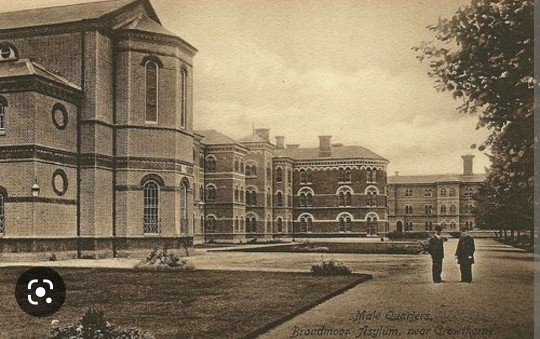

An In-Depth Look at the History of Psychiatric Care in Broadmoor Prison
When you hear the term ‘insane asylum,’ what do you envision? The history of Hollywood movies has done a fantastic job at painting a picture of a foreboding, ivy-covered building that housed mentally ill individuals locked in padded rooms, drooling on themselves after their last round of electroshock therapy destroyed their ability to function. Unfortunately, up until the late 1800’s and early 1900’s, this was very accurate. For hundreds of years, mentally incapacitated individuals were often left at county psychiatric hospitals and prisons only to be forgotten by their friends and family; there was little to no understanding of the human psyche, and the idea of ‘mental illness’ was far from being understood. Due to this lack of understanding and compassion, an indistinguishable amount of patients died under the care of psychiatric doctors and nurses for symptoms as simple as ‘excitability or melancholy.’ It wasn’t until the drafting of the ‘Criminal Lunatics Bill’ in 1860 that there was a true shift in the proper treatment and understanding of mentally ill individuals; thus began the construction of England’s most notorious psychiatric hospital that housed some of the country's most violent offenders.
Prior to the construction of Broadmoor, the mentally ill were confined within the grounds of prisons and county asylums; they were often put together in large groups in prison yards, regardless of the severity or cause of the mental illness. W.D. Hood, the superintendent of Bethlem Psychiatric Hospital and John Charles Bucknill raised concern to the public that the wretched conditions in which the humans were being kept would make treatment impossible. The grounds of Bethlem Hospital in which these patients were kept was referred to as ‘hell on earth’ and Hood himself quoted the author Dante “All hope abandon, ye who enter here” in reference to the hopeless conditions. The ‘Criminal Lunatics Bill’ was soon passed as a way to protect the mentally ill and the construction of Broadmoor Hospital soon began.
Broadmoor was first officially opened in 1863; the building included a female block with a max capacity of 100 women and a men’s block that had six separate units with a max capacity of 400 men. The purpose of the separate cell blocks for the men was in order to classify and separate violent, dangerous offenders from offenders who were there for petty crimes.
When the doors first opened in 1863, Broadmoor only accepted 98 female patients. It wasn’t until the following year that 221 men arrived at Broadmoor Prison from England; 25% of these men were convicted murderers. Shockingly, though, roughly 40% of the women there were convicted murderers and of these murders, a majority of the women were there for harming or killing their children. Postpartum depression and Postpartum psychosis were not officially recognized as serious mental afflictions until the release of the DSM-4 in 1994. Therefore, for any women suffering from postpartum depression, they were not offered any semblance of help until after they had reached a crisis point. Doctors in the 1800’s and 1900’s referred to what we know as Postpartum depression as ‘Puerperal Disorders’ and described the symptoms as a total loss of interest in life, happiness, and their newborn child by women who were seemingly ‘normal’ before giving birth. When a newly postpartum mother was brought in with a ���puerperal disorder,’ it was often recommended that she take hot baths, sleep, and was given complete isolation; essentially, doctor’s believed this disorder was caused by too much stimuli and stress following the trauma of childbirth and isolation would benefit a new mother. Clearly, there weren’t many benefits to this. Postpartum depression has been discussed for millenia; in 460 b.c., Hippocrates referred to this condition as ‘puerperal fever,’ with symptoms including mania, agitation, and delirium. It wasn’t until the 21st century that physicians truly began to understand the causes of this debilitating disorder.
Broadmoor had a wide range of patients ranging from arsonists, burglars, and gangsters to rapists, murderers, and cannibals. Broadmoor held some of England’s most notorious criminals, one of the many reasons it earned such a reputation; Peter Sutcliffe, or better known as the Yorkshire Ripper, Robert Maudsley, better known as Hannibal the Cannibal and James Kelly, a possible suspect for Jack the Ripper were all housed here. James Kelly made an infamous escape on January 23, 1888 and was missing for nearly four decades before turning himself back in when his health started failing; he passed away two years after returning to Broadmoor.
Despite its reputation for the extremely violent criminals it housed, Broadmoor was constructed in a time of heavy psychiatric pessimism and the doctors and nurses who worked in Broadmoor were truly trying to enact change. It was always the intention to rehabilitate these patients and in order to ensure this, the ‘Criminal Lunatics Bill’ required an annual check of how Broadmoor was being run by the Home Secretary as well as offered an appointed counsel of people to oversee various aspects of how Broadmoor was being run.
William Orange, Broadmoor’s superintendent for the years of 1870 to 1876 is quoted saying:
“It cannot be lost sight of that one object with which patients have been sent to this asylum, is that they might receive such treatment as may be calculated to promote the recovery of their mental health.”
For the entirety of his time being Broadmoor Superintendent, Orange ensured that patients had access to recreation activities as well as provided patients the opportunity to work jobs that aimed at helping them become productive members of society.

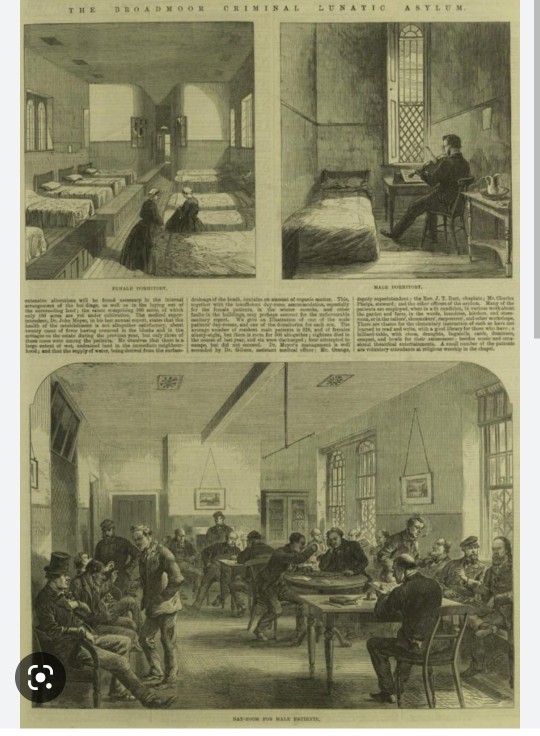
Over the decades, Broadmoor changed from superintendent to superintendent, but when referring to patient letters to their families at that time and doctor notes on their patients, it truly seems Broadmoor set the stage for stopping psychiatric pessimism in the Victorian Era.
Beyond a Reasonable Doubt
1 note
·
View note
Photo

It was the 23rd of May, 1996, when a man was walking along a wooded canal bank on Old U.S. 27 in Clewiston, Palm Beach County, Florida. He was searching for scrap metal and cans when he came across a maroon and white Indian or Mexican style blanket and a woman’s black and white sweater. The area was in a seldom travelled dead-end road, around two miles from Hendry County.
The man decided he would investigate. As he got closer to the blanket and sweater, he noticed that there was a deceased baby girl wrapped up inside. She was estimated to be between four and six weeks old and was either white or Hispanic. The baby girl had black or dark brown hair. Due to decomposition, it couldn’t be determined what colour her eyes were.
The man immediately called police who cordoned off the area and transported the body to the medical examiner’s office for an autopsy to be conducted. It would determine that she had been dead for around five days. She also had a fractured mandible and maxilla and had died either of accidental or intentional injures.
𝐑𝐞𝐚𝐝 𝐌𝐨𝐫𝐞:
https://morbidology.com/the-mystery-of-baby-belle/
49 notes
·
View notes
Text
Who is “Little Jane Doe” found in St. Louis, MO 1983?
Detective Joe Burgoon remembers every detail of the day he first came across little Jane Doe; the cold chill of the basement that kept the smell of her decomposing corpse at bay, the trails of blood on the floor from where her murderer dragged and disposed of her, her chipped crimson-red nail polish that matched the color of the nylon rope used to bound her hands, and the latin word “Domi” or Home etched into the stone above the doorway of the forsaken building.
It was a mild February day in 1983 when two men stumbled into an abandoned apartment building in search of a pipe wrench to fix their broken down vehicle. Failing to locate anything of use on the main floor the men ventured into the dark, cold basement in hopes to better their luck. With no range of vision, one man lights up a cigarette to brighten up their surroundings only to see a gruesome scene; a headless, bound body that was sitting among rubble, discarded like trash.
When officers arrive they had no way of identifying the body without the head, which lead them to believe the corpse was possibly a prostitute or drug addict that lived in a nearby housing project. While searching the vicinity of the building for the head, the rest of the body is taken to the local medical examiner’s office to search for any clues as to where she came from. During the autopsy it was revealed that their “Jane Doe” was not a drug addict who overdosed or a prostitute who was murdered after hopping into the car with the wrong person; she was a little girl between the ages of seven and twelve. She was of African American descent and through DNA testing done by the Smithsonian institute it was concluded that she had spent most of, if not all of her life in one of ten southeastern states: Florida, Georgia, Alabama, Mississippi, Louisiana, Arkansas, Texas, Tennessee and the Carolina’s.
Once it was determined that their Jane Doe was a child, local law enforcement went to every school district in the vicinity of where her body was located trying to determine her identity; when they found no missing students it further proved that the DNA testing was correct about her origins. Despite the fact that it is believed she was not a local to St. Louis, Missouri it is believed that her killer was. Due to the placement of her remains and the fact that the building was nowhere near any major freeways or roads it is believed that her murderer could have possibly been a transient with knowledge of local abandoned buildings.
Joe Burgoon, like countless others, remember Little Jane Doe for the person she could have been and will continue to fight to keep her memory alive.
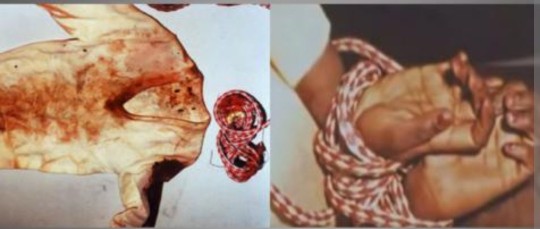
#crime#criminology#journalism#psychology#writing#murder#unsolved murder#unsolved case#unsolved mysteries#true crime#unsolved true crime#true crime community#tc community
3 notes
·
View notes
Text
Unsolved Mystery: What happened to the three sole escapees of Alcatraz?


Located in the center of San Francisco Bay, Alcatraz, or more famously known as the world's most fortified and inescapable prison, held some of histories most infamous criminals such as Alcapone, George "Machine Gun Kelly," and Whitey Bulger. From 1934 to 1963, 36 men unsuccessfully attempted to escape the prison with all attempts resulting in recapturing or death. However, in 1960, fate joined the paths of three infamous criminals who would change the history of this prison forever.
On June 12, 1962 during a routine morning check, a prison guard noticed inmates John Anglin, Clarence Anglin, and Frank Morris were missing from their cells. In their beds were masterfully made dummy heads made of flesh tone paint and real human hair. A prison wide lock-down was immediately ordered and the prison was thoroughly searched. However, none of the men were found and it was clear that they had just made Alcatraz history as being the first successful escapees.
During the investigation into the escape, it was found that all three men had made seperate unsuccessful escape attempts. It wasn't until fate brought the three of them together in adjoining cells that their masterful plan was concocted. The entire event became possible when one of the inmates discovered saw blades that were used to dismantle the air vents in their cells. Cutting tiny holes directly next to one another, they were eventually able to completely saw a hole through the air vent and gain access to a corridor directly behind their cell block where they created a workshop. In this workshop they managed to fashion together life preservers and a life raft made from over 50 stolen raincoats that had been collected over the 18 month planning process. In order to "vulcanize" the seams of the raft closed, they melted it against hot steam pipes in the prison and inflated the raft by converting a musical instrument into a makeshift air pump. Despite a 30 foot ceiling height, the men managed to climb a network of pipes and gain access to the ventilator which was opened using a bolt carved out of soap. Once through the ventilator, they then climbed to the roof, shimmied down the bakery smoke stack, climbed over the prison fence and launched their raft off the northeast shore of the island.



Other than a packet of letters sealed in rubber and pieces of paddle found on Angel island, no evidence of the men either perishing or surviving has ever been found. According to a prison informant, the plan was to cross the bay to Angel Island, cross Raccoon Straight into Marin County where they would then steal clothes and a vehicle. However, no thefts such as this were ever reported in the area.
For some idea to the feat of what these men accomplished if they somehow did survive, I'll include some detail of the island itself. It sits in the center of San Francisco Bay, which is roughly 15 nautical miles away from the closest shore. The average temperature of the water in the pacific ocean is 38 degrees Fahrenheit, or roughly three degrees Celsius. Maybe it's just me, but if they found a paddle at Angel island but never found any other clues to connect where they went, I'm willing to bet they died from dehydration or starvation after somehow getting stuck at Angel Island.
Without sufficient clues or evidence to pursue them, the FBI officially closed the case on December 31, 1979.
https://www.fbi.gov/history/famous-cases/alcatraz-escape
Coldcaseblogger
#crime#criminology#journalism#psychology#writing#unsolved disappearance#unsolved mysteries#missing#prison#escape#true crime#unsolved true crime#true creepy stories
1 note
·
View note
Text
The Lost Women of Ciudad, Jaurez: Giving a Name to Rising Female Homicide in Mexico

For the past two decades, the city of Ciudad, Juárez has been gripped with fear for their daughters, sisters, and wives from the growing violence against women in Mexico. Now considered a pandemic by the United Nations, female homicide rates are at an all time high. Hundreds of parents that are interconnected by a morbid planetary fate have been asking the same question: Who is violently raping and murdering their daughters on the outskirts of Juárez, Mexico? Between 1993 and 2005, more than 370 young girls and women have been found tortured, mutilated, and murdered in the deserts of Mexico. Many of the girls shared the same characteristics: Over 70% of the girls were teenagers that came from poverty stricken backgrounds, a majority of them were either Maquiladora (factory) workers or students, and they shared the same physical characteristics such as having a slender build, dark toned skin, dark eyes, and dark, shoulder length hair. Out of the nearly 400 reported murders over a decade long time span, one third of those cases involved violent sexual assault. Despite the vast amounts of missing women, only roughly 20% of those cases are presumed “solved” with a majority of the victims remaining unidentified. According to the citizens of Juárez, a lack of respectable police work is behind the continued slaying of women in their city. Why do you believe there aren’t more precautions put into place to protect its citizens and most importantly, who is doing this?
Ciudad, Juárez is considered “The Gateway to the North” due to its placement against the United States. With only the city of El Paso, Texas and the Rio Bravo River separating these two countries, it attracts high levels of gang violence and drug smuggling due to easy importing and exporting of goods at the border. Despite the high levels of gang violence, only roughly 70% of the murders committed between 1993 and 2005 were due to gang violence, with one third of them being violent sexual assaults against women.
On May 12, 1993 the body of an unidentified woman was found in the slopes of Cerro Bola laying on her back with her trousers unzipped and pulled down around her knees. It was immediately clear that she suffered a frenzied attack; She suffered bite wounds to her breast and nipple, abrasions to her jaw and right cheek, an abrasion to her chin, and was bleeding in her nose and mouth. Her bra was pushed up revealing her breasts. The first victim of “feminicidio” had light brown skin, was approximately 24 years old and her cause of death was asphyxia caused by strangulation; she remains unidentified.
Between May and October of 1993 ten bodies were found on the outskirts of Juárez; all ten of these bodies showed signs of sexual assault.
During the year of 1994, at least seven women came forward and reported being raped and strangled. A twelve year old girl was found murdered after walking to a public bus stop. For these crimes, five men were arrested and charged.
On August 22, 1995 the skeletal remains of sixteen year old maquiladora worker Angélica Márquez Ledezma were found next to an unidentified woman she worked with. On the day of her disappearance, she left for work with her husband and never returned home.
On September 1, 1995 the body of sixteen year old Silvia Elena Rivera was found- eight days later, the body of twenty year old Olga Alicia Carrillo was discovered. Both victims showed evidence of having pieces of their breasts and nipples bitten off; due to an advanced state of decomposition, it was impossible to determine if these wounds were inflicted by scavenging animals or if they suffered them during their murders.
At the end of 1995, sixteen year old Cecelia Covarrubia, her newborn child, and her two friends Adriana Torres and Ignacia Morales went missing. The three girls’ bodies were located but Cecelia’s newborn is never found.
There were 42 recorded murders in 1995 and in eighteen of those cases, there was evidence of sexual assault.
Between March and April of 1996, eight bodies are discovered on the outskirts of the city. These bodies include the semi-naked bodies of sixteen year old Verónica Guadalupe Castro and seventeen year old Rosario Garcia Leal. The victims were bound with their own shoelaces- Verónica’s cause of death was fatal stab wounds and Rosario died from asphyxia caused by strangulation. The remaining six girls found could not be identified.
On July 8, 1996 seventeen year old maquiladora worker Sandra Jaurez failed to make it to work and was later discovered murdered by strangulation.
On August 10, 1996 the body of fourteen year old maquiladora worker Sandra Ivette Ramirez was discovered after failing to return home from her shift.
In December of 1996 fifteen year old Brenda Lizeth Najera and thirteen year old Susanna Flores are found dead. Both victims showed signs of violent sexual assault and torture.
In 1996, 43 women were murdered with 19 cases showing evidence of sexual assault; a majority of those girls remain unidentified.
Between March and April of 1997, ten women went missing and were found murdered. Six of them were naked and showed signs of sexual assault. Five of these victims were identified as ten year old Cinthia Rocio Acosta, eleven year old Ana Maria Gardea, nineteen year old Maribel Palomino, nineteen year old Sylvia Guadalupe, and sixteen year old Myriam Aguilar. Out of the 37 women murdered in 1997, sixteen were sexually assaulted and only eight were identified.
On January 3, 1998 the body of thirteen year old Jesica Martinez Morales is found. On March 11 Silvia Arce is reported missing and is never seen again. On April 21, 1998 the body of 22-year-old Argelia Irene Salazar is discovered semi naked under a railway bridge. She was last seen on her way to work at a maquiladora factory.
The body of a Dutch tourist, Hester Van Nierop was discovered under a hotel bed with her throat cut.
In 1998 a total of 38 women were murdered, with 17 of them being sexually assaulted.
In July of 1998 the Comision Nacional de Derechos Humanos, or National Human Rights Convention recommended that under official review, that the judicial, state, and municipal authorities of Ciudad, Juárez and Chihuahua, Mexico were guilty of negligence and dereliction of duty. Shortly after, the Special Prosecutors Office for the Investigation of the Murders of Women was founded.
In 1999, a fourteen year old girl survived a brutal sexual assault before being left for dead in the deserts of Mexico. Miraculously, she survived the attack and identified her attacker: Jesús Manuel Guardado Márquez, nicknamed “El Tolteca,” was a bus driver for the Maquiladora she worked for. After his arrest, he gave the names of four other men that were involved in the murders of 20 Maquiladora workers between 1998 and 1999.
In order to process the magnitude of the problem of femicide in Mexico, one must ask two crucial questions: Why is this happening and what can we, as a nation do to stop it?
According to IACHR Special Rapporteur, 257 women that went missing between 1993 and 2002 remain unaccounted for. However, non-governmental organizations located in Mexico claim that the number is well over 400. Out of the nearly 400 women that went missing, 50% of the victims were between the ages of 13 and 22, making adolescents the main target of these brutal attacks. 70% of the victims from 1993 to 2002 died from asphyxia caused by strangulation or blunt force trauma. Of all of these murders, and despite the similarities between assaults, only 20% are considered “solved.”
In July of 2017 the Mexican government and local Human rights activists created a smartphone app called “No Estoy Sola,” or “I Am Not Alone.” The program is designed to send a distress call to five preloaded contacts in your phone in the event of an attack or kidnapping. By shaking the phone or pressing any button, a message containing your coordinates is sent directly to your preloaded contacts. Many civilians in Mexico do not choose to download authorities onto this distress call for lack of trust in their abilities and motivations.
With the sheer number of young women and girls that have went missing or been brutally murdered in Juárez and chihuahua, how has the Mexican government not done more to protect this young age group? The statistics are there- the likelihood of Mexican authorities solving a murder, rape, or disappearance is less than 30%- and the numbers of violent assaults and murders is rising. In 2016, Juárez’s murder rate doubled from its 2015 statistics. If you are a citizen of Juárez, for every 100,000 residents, statistically there will be 43.63 homicides.
What do you believe is the cause of femicide in Mexico?
Sources: http://www.womenontheborder.org/sex_serial_english.pdf
https://www.amnesty.org/en/documents/amr41/026/2003/en/
https://www.washingtonpost.com/news/morning-mix/wp/2017/07/10/hundreds-of-women-disappear-in-ciudad-juarez-each-year-a-smartphone-app-could-help/?noredirect=on&utm_term=.89a807892f2a
#crime#criminology#journalism#writing#unsolved case#unsolved murder#unsolved true crime#unsolved disappearance#femicide#homicide#murder#justice#true crime#true crime community#creepy#true creepy stories
4 notes
·
View notes
Text
Profile of a Killer: Robert Berdella
Warning: Extremely Graphic Depictions of Sexual Violence
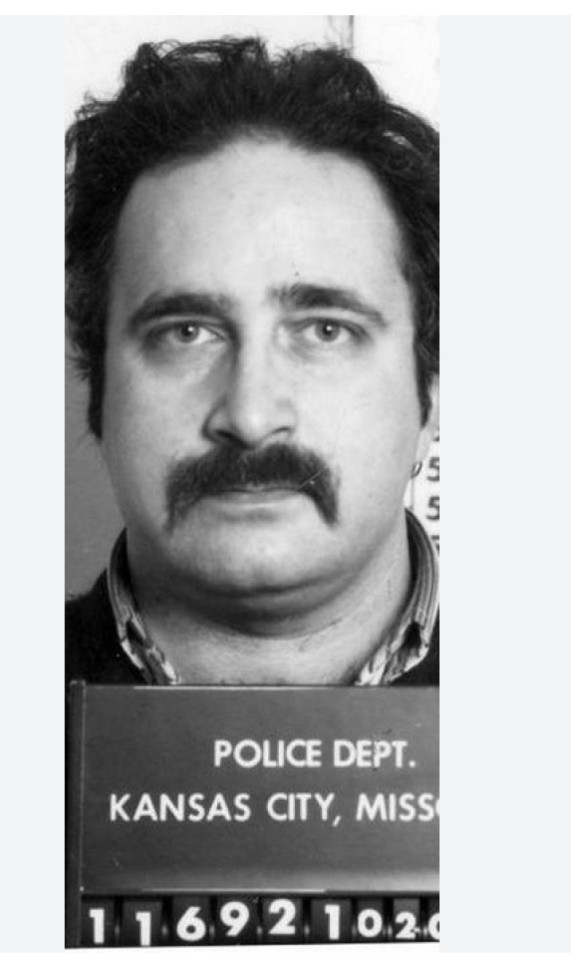
Early life
Born in Cuyahoga Falls, Ohio, Robert Berdella was the first of two sons born to Robert Berdella Senior and Mary Berdella. Born with a speech impediment and vision issues, Robert was raised in a strict catholic household, regularly going to mass and religious education courses. Due to health issues, Robert was forced to sit out on athletic activities whereas his little brother showed an aptitude for many different sports. Due to his father viewing sports and athletic activity as a sign of accomplishment, Robert was always viewed as a failure. When Robert reached puberty, he realized he was homosexual and kept it a secret from his family; Robert briefly had a girlfriend in his teenage years. After his father passed away in 1965 from a heart attack, he sought religion as a place of comfort. He read extensively on all types of religions but later became cynical towards his faith. Shortly after, Robert saw the film 'The Collector,', a movie based around a woman being held captive in a basement by two men; he later claimed this was the driving force towards his own Modus Operandi.
Making of a monster
In 1967, Robert graduated from high school and enrolled into Kansas City Art Institute; at first he was known as a dedicated, attentive student. However, he soon became involved in selling drugs to students at the college. In two known incidents, Robert tortured a duck and a chicken in the presence of his peers and tested tranquilizers on a dog. By the age of 19, he made a name for himself with the Johnson County police department after being arrested for selling methamphetamines to an undercover officer. A month later, he and another student were arrested for possession of marijuana and LSD. Shortly after, Robert left the institute when he was criticized by the Board of Directors for hurting animals.
Beginning of the End
Known by his neighbors as a helpful and flamboyant man, he became immersed in the community surrounding his home by helping a local crime prevention association; he later became chairman of the local neighborhood watch. After moving into his home on 4315 Charlotte Street, Robert opened Bob’s Bazaar Bizarre at a local flea market selling primitive art, jewelry and antiques. Despite some days making a generous profit, he often didn’t earn enough to make ends meet and this resulted in Robert scavenging for any items to sell and allowing people to stay at his home for rent. A local merchant, Paul Howell befriended Robert and soon after Paul’s younger son, Jerry became friends with him as well. Despite Jerry and his friends taunting Robert for his sexuality, he later confided in him that he and his friends worked as male prostitutes.

Murders
Jerry Howell
On July 5, 1984 Berdella murdered his first victim and friend, 19-year-old Jerry Howell. Robert claimed that he fed Jerry alcohol, Valium, and acepromazine until he became unconscious, after which he tied the young man to his bed. Restrained to the bed for approximately 28 hours, Robert repeatedly raped, tortured and violated Jerry with foreign objects until he passed away from asphyxiation from the gag in his mouth and choking on his own vomit. After Jerry passed away, Robert drained his body of blood and dismembered him with a chainsaw and boning knives. He then wrapped the sections in newspaper and threw them in trash cans for the garbage crew to take to the local landfill.
Robert Sheldon
On April 10, 1985 23-year-old Robert Sheldon showed up on his doorstep asking for a place to stay. For three days he held him captive, shoved needles under his nails, filled his ears with caulking, and bound his hands with piano wire in attempt to permanently damage the nerves in his hands. On April 15, Berdella suffocated Sheldon and dismembered his body in his third floor bathroom.
Mark Wallace
Finding Mark inside his tool shed seeking shelter, Robert invited him into his home and offered him chlorpromazine to help calm and relax him. Mark willingly accepted, and 30 minutes later Berdella tied him up and attached alligator clips to his nipples to facilitate electrical shocks. Within an hour, Wallace fell into a state of unconsciousness and passed away around 7 p.m. on June 23.
James Ferris
On September 26, 1985 Berdella invited his acquaintance James Ferris to stay at his home. Picking him up from a local bar, Berdella drugged him with tranquilizers and proceeded to torture Ferris for nearly 27 hours. He subjected him to 7,700 volts of electric shocks to his shoulder and testicles for up to five minutes at a time. All the while, Berdella inserted hypodermic needles into his neck and genitals. Shortly after, Ferries died.
Todd Stoops
Previously living with Berdella, a chance encounter between the two solidified Stoops fate; after inviting him to his house for lunch, he drugged him and his two-week torture plan with Stoops began. Berdella used electrical shocks through his eyelids to attempt to blind him and injected drain cleaner into his larynx to silence his screams. In the second week of captivity, Berdella ruptured Stoops anal wall with his fist which caused septic shock. On July 1, 1986 Todd Stoops succumbed to his injuries.
Larry Wayne Pearson
Meeting Berdella at his Bazaar shop, the two quickly became friends. Shortly after, Pearson began living with Berdella and even did chores around the house as a way of paying rent. He initially didn’t plan on killing Pearson, but after he began jokingly referring to his practice of robbing gay men in Wichita, Berdella injected him with chlorpromazine and brought him to his basement. Being the most submissive victim thus far, Berdella agreed to allow him to move to a bedroom. As long as he didn’t rebel he would not continue to inflict as much pain on him. After six weeks of captivity, Pearson bit into Berdella’s penis, screaming that he can’t do this anymore. Berdella first bludgeoned him with a tree limb then suffocated him.
Final victim- Christopher Bryson
On March 29, 1988, Berdella abducted his final victim, a 22 year old male prostitute by the name of Christopher Bryson. With a promise of sex, Berdella lured him to his home and knocked him unconscious with an iron bar. Once bound to the bed, he was tortured in a manner like previous victims; although swabbing his eyes with ammonia was unique to his torture. After a few days, Berdella began to trust Bryson and was willing to discuss aspects of the abuse he was being subjected to. He finished the conversation with a warning:
“I’ve gotten this far with other people before, and they’re dead now, because of mistakes they made.” Now earning his trust, Bryson convinced Berdella to tie his hands in front of his body instead of behind, preventing loss of circulation to his hands. Lighting his restraints with a book of matches Berdella forgot in the room, he jumped out of the second floor window, breaking his ankle in the process and ran towards a meter reader shouting for them to call the police.
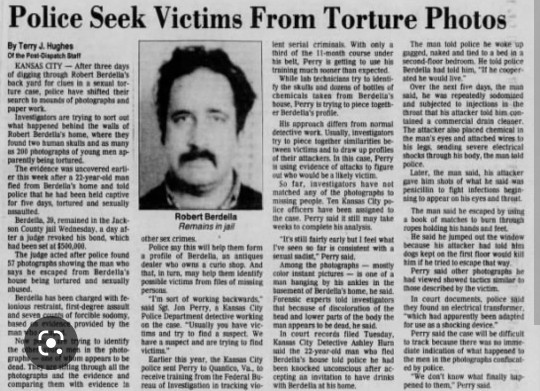

Arrest
After the discovery of Bryson, authorities searched Berdella’s home and found the electrical transformer with the wires leading to the bed, a metal tray holding syringes and a long iron pipe. Searching the whole home, investigators located a human skull, human vertebrae and several human teeth hidden in envelopes. 334 Polaroid pictures and 34 snapshot prints of different males were found in Berdella’s home which depicted his victims in life and death. Accepting a plea bargain, he confessed in graphic detail how he killed each victim, what forms of torture he used against them, and what he did with their bodies. On December 19, 1988 Berdella was charged with one count of first degree murder (of Robert Sheldon) and four counts of second degree murder. In response to his guilty pleas, the judge imposed another five concurrent life sentences.
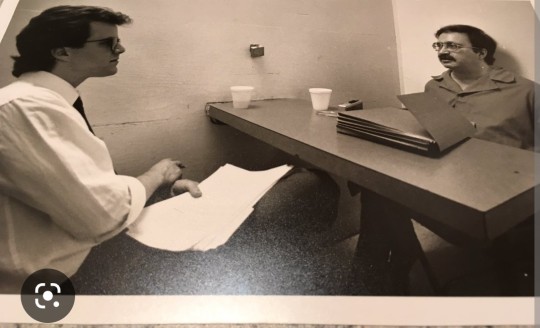
At 3:55 p.m. on October 8, 1992 Berdella died of a heart attack in the prison infirmary at the age of 43.
Beyond a Reasonable Doubt
#crime#criminology#journalism#psychology#writing#criminal law#justice system#true creepy stories#creepy#did you know#true crime community#serial#serial killer#murderer#Macabre#psychopath
10 notes
·
View notes